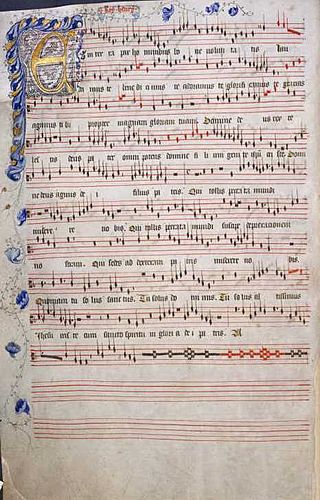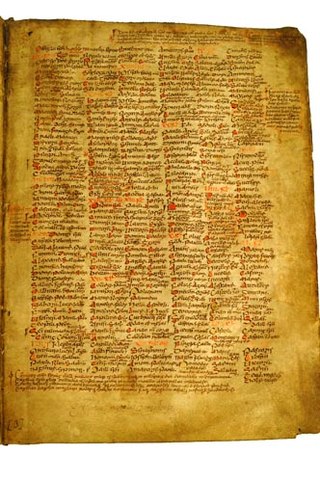
The Red Book of Hergest, Oxford, Jesus College, MS 111, is a large vellum manuscript written shortly after 1382, which ranks as one of the most important medieval manuscripts written in the Welsh language. It preserves a collection of Welsh prose and poetry, notably the tales of the Mabinogion and Gogynfeirdd poetry. The manuscript derives its name from the colour of its leather binding and from its association with Hergest Court between the late 15th and early 17th century.

The Old Hall Manuscript is the largest, most complete, and most significant source of English sacred music of the late 14th and early 15th centuries, and as such represents the best source for late Medieval English music. The manuscript somehow survived the Reformation, and formerly belonged to St. Edmund's College, a Roman Catholic school located at Old Hall Green in Hertfordshire. It was sold to the British Library after an auction at Sotheby's in 1973.
The Song of Dermot and the Earl is an anonymous Anglo-Norman verse chronicle written in the early 13th century in England. It tells of the arrival of Richard de Clare (Strongbow) in Ireland in 1170, and of the subsequent arrival of Henry II of England. The poem mentions one Morice Regan, secretary to Dairmaid mac Murchadha, king of Leinster, who was eyewitness to the events and may have provided an account to the author.

Calcidius was a 4th-century philosopher who translated the first part of Plato's Timaeus from Greek into Latin around the year 321 and provided with it an extensive commentary. This was likely done for Bishop Hosius of Córdoba. Very little is otherwise known of him.
Wolfgar or Wolfger was the bishop of Würzburg from 809/10 until his death in 831/2. He succeeded the obscure bishop Egilwart (803–09/10).

A carpet page is a full page in an illuminated manuscript containing intricate, non-figurative, patterned designs. They are a characteristic feature of Insular manuscripts, and typically placed at the beginning of a Gospel Book. Carpet pages are characterised by mainly geometrical ornamentation which may include repeated animal forms. They are distinct from pages devoted to highly decorated historiated initials, though the style of decoration may be very similar.

Heraldic visitations were tours of inspection undertaken by Kings of Arms throughout England, Wales and Ireland. Their purpose was to register and regulate the coats of arms of nobility, gentry and boroughs, and to record pedigrees. They took place from 1530 to 1688, and their records provide important source material for historians and genealogists.

Secundinus, or Sechnall as he was known in Irish, was founder and patron saint of Domhnach Sechnaill, County Meath, who went down in medieval tradition as a disciple of St Patrick and one of the first bishops of Armagh. Historians have suggested, however, that the connection with St Patrick was a later tradition invented by Armagh historians in favour of their patron saint and that Secundinus is more likely to have been a separate missionary, possibly a companion of Palladius.

Acallam na Senórach, is an important prosimetric Middle Irish narrative dating to c. 1200. It is the most important text of the Finn Cycle and at about 8,000 lines is the longest-surviving work of medieval Irish literature. It contains many Finn Cycle narratives framed by a story in which the fianna warriors and Caílte mac Rónáin have survived long enough to relate the tales to Saint Patrick. The work has been seen as a defence of the Irish literary establishment when it came under the scrutiny of Church reformers during the 12th to 13th centuries.

The Athelstan Gospels, or British Library, Cotton MS Tiberius A. ii is a late 9th or early 10th-century Ottonian illuminated Gospel book which entered England as a gift to King Athelstan, who in turn offered it to Christ Church, Canterbury. It is also referred to as the Coronation Gospels on account of an early modern tradition that it had been used as an oath-book at English coronations.
The Vita tripartita Sancti Patricii is a bilingual Life of Patrick, written partly in Irish and in parts in Latin. It is a hagiography focusing on Patrick. The text is difficult to date. Kathleen Mulchrone had assigned a late ninth century date based on the latest historical reference in the text. However, on linguistic grounds, it has been dated to as late as the twelfth century. The text as it stands probably reflects various stages of development. Máire Herbert summarises:
While there are some textual references indicative of ninth-century date, in my opinion the text was continued thereafter and completed around or after the mid-tenth century. Some decades later, in the eleventh century, the text was edited as a tripartite homily designed for preaching during celebration of the saint's feast.

The Martyrology of Tallaght, which is closely related to the Félire Óengusso or Martyrology of Óengus the Culdee, is an eighth- or ninth-century Irish-language martyrology, a list of saints and their feast days assembled by Máel Ruain and/or Óengus the Culdee at Tallaght Monastery, near Dublin. The Martyrology of Tallaght is in prose and contains two sections for each day of the year, one general and one for Irish saints. It also has a prologue and an epilogue.
Dublin, Royal Irish Academy, MS 23 N 10, formerly Betham 145, is a Gaelic–Irish medieval manuscript.
Oxford, Bodleian Library, Rawlinson B 502 is a medieval Irish manuscript which presently resides in the Bodleian Library, Oxford. It ranks as one of the three major surviving Irish manuscripts to have been produced in pre-Norman Ireland, the two other works being the Lebor na hUidre and the Book of Leinster. Some scholars have also called it the Book of Glendalough, in Irish Lebar Glinne Dá Locha, after several allusions in medieval and early modern sources to a manuscript of that name. However, there is currently no agreement as to whether Rawlinson B 502, more precisely its second part, is to be identified as the manuscript referred to by that title.
Saint Nath Í or Nathí, also anglicised to Nathy, was an early Irish saint of the Dál Messin Corb, who was credited with the foundation of Cúl Fothirbe in Dál nAraide territory and with becoming its first bishop. He is not to be confused with Nath Í, bishop and founder of Sruthair Guaire and brother to co-founder Domoingen.

Abbán of Corbmaic, also Eibbán or Moabba, was a saint and abbot. He is associated, first and foremost, with the Mag Arnaide. His order was, however, also connected to other churches elsewhere in Ireland, notably that of his alleged sister Gobnait.

The Manuscrit du Roi or Chansonnier du Roi is a prominent songbook compiled towards the middle of the thirteenth century, probably between 1255 and 1260 and a major testimony of European medieval music. It is currently French manuscript no.844 of the Bibliothèque nationale de France. It is known by various sigla, depending on which of its contents are the focus of study: it is troubadour manuscript W, trouvère manuscript M, and motet manuscript R. It was first published by French musicologist Pierre Aubry in 1907.
Kathryn Margaret Rudy is a manuscript historian at the University of St Andrews, Scotland. She is best known for her forensic approach to medieval books, and has pioneered the use of the densitometer to measure the grime that original readers deposited in their books. Her research focuses on the medieval reception of manuscripts, how they were manipulated and handled, and how book-making skills were lost with the advent of the printing industry.
Oxford, Bodleian Library, MS Fairfax 16, also known as the Fairfax Manuscript, is a fifteenth-century Middle English poetic anthology which contains one of the finest collections of Chaucerian verse of this period. Owned and commissioned by John Stanley of Hooton, Cheshire, Fairfax 16 was produced in Oxford or London in the mid-fifteenth century. Thomas Fairfax bequeathed it to the Bodleian Library in 1671.